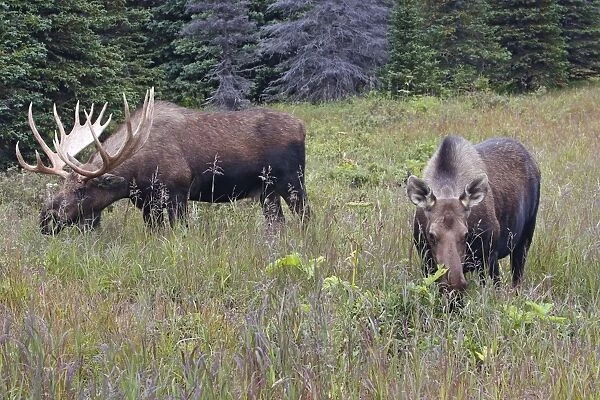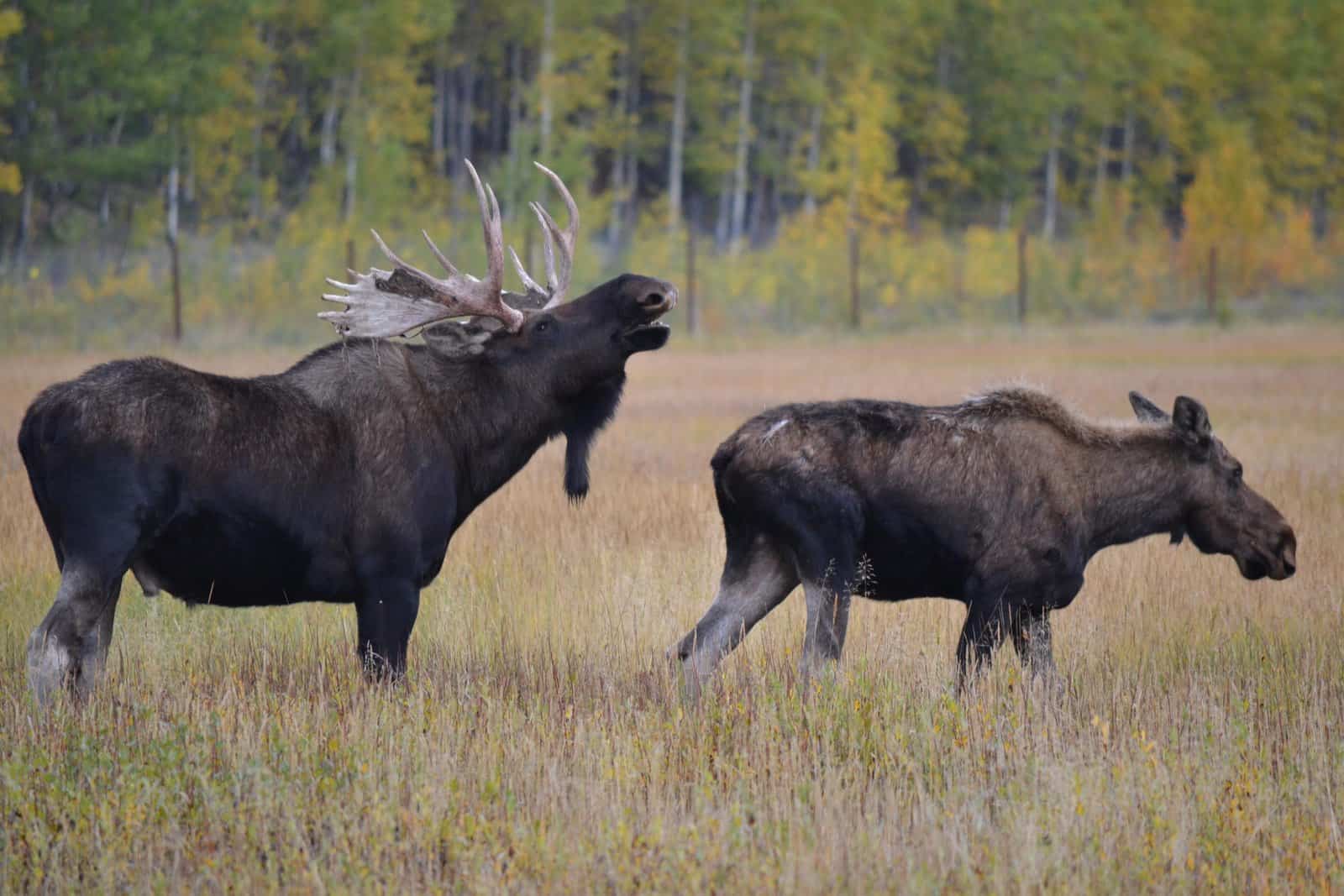The male moose is called a bull, and the female moose is referred to as a cow. Male and female moose differ in size, antler shape, and behavior.
Moose are known for their impressive size and striking appearance. The male, or bull, moose is much larger than the female, or cow, and typically has larger, broader antlers. Male moose also tend to be more aggressive during the mating season, whereas female moose are typically more protective of their young.
Understanding the distinctions between male and female moose can provide valuable insights into their behavior and natural habitat.
The Moose Species
Moose are the largest species of deer, with males known for their impressive antlers and females for their smaller, more delicate appearance. Both genders are known for their solitary nature, with males showcasing dominance during mating season through vocal displays and antler fights.
The Moose Species Male and female moose, belonging to the Alces alces species, exhibit fascinating traits and behaviors. Let’s dive into the unique aspects of Physical Characteristics, Habitat and Distribution of these majestic creatures.Physical Characteristics
Moose have distinctive features like antlers, which are larger in males and serve as display during mating season. Their body size can vary greatly between the sexes. Moose are known for their prominent noses and long legs, aiding in their movement through various terrains.Habitat And Distribution
Moose predominantly inhabit forests and wetlands, preferring areas with abundant vegetation for grazing. They are found in regions of North America like Canada and Alaska. Marshy areas are particularly favored by moose due to the availability of aquatic plants for food and water.Differences Between Male And Female Moose
The main difference between male and female moose lies in their physical size and antler characteristics. Male moose, known as bulls, are larger and possess larger antlers compared to female moose, called cows. These distinctions play a crucial role in their behavior and reproductive strategies.
Physical Differences
Male moose are typically larger than females, with antlers that can span up to six feet in width, whereas females lack antlers altogether.
Behavioral Variances
Males are more territorial and aggressive during the mating season, while females tend to be more protective of their calves.
Mating And Reproduction
Mating and reproduction are crucial stages in the life of male and female moose. These processes not only ensure the survival of the species but also have a significant impact on the population dynamics of these majestic creatures in their natural habitats.
Mating Rituals
The mating rituals of male and female moose are fascinating to observe. During the rutting season, which typically occurs in the fall, male moose engage in elaborate displays of dominance and aggression to establish their mating rights. This behavior involves vocal calls, posturing, and physical combat between rival males to win the attention of receptive females. The victorious male then proceeds to court and mate with the chosen female, often engaging in a vocal and physical courtship display.
Impact Of Reproduction On Population
The reproductive success of male and female moose has a direct impact on population dynamics. High rates of reproduction can lead to an increase in the moose population, while low reproductive success may result in a decline. Factors such as predation, habitat quality, and food availability also play a critical role in determining the overall impact of reproduction on the moose population. Understanding these dynamics is essential for wildlife conservation and management efforts aimed at maintaining healthy and sustainable moose populations in their natural ecosystems.

Credit: www.eslbuzz.com
Challenges And Threats
Moose, both male and female, face several challenges and threats in their natural habitat.
Habitat Loss
One of the biggest challenges that male and female moose face is habitat loss. With urbanization and deforestation on the rise, their natural habitats are shrinking rapidly. As a result, moose populations are being pushed into smaller and fragmented areas, making it harder for them to find enough food and suitable breeding grounds. This loss of habitat also increases the risk of human-moose conflicts, as moose are forced to venture closer to populated areas in search of resources.
Predators And Hunting
Male and female moose are also vulnerable to predators and hunting. Predators such as wolves and bears pose a threat to moose populations, especially when they are weakened by age, injury, or harsh winters. Additionally, human hunting can have a significant impact on moose numbers if not properly regulated. While hunting can be managed sustainably under strict guidelines, overhunting can lead to population decline and ecological imbalances.
In some regions, hunting poses a greater threat to moose populations than predators. Unregulated or illegal hunting practices can result in increased mortality rates, particularly among male moose targeted for their antlers and meat. This can disrupt the natural balance between male and female moose, affecting their breeding patterns and overall population stability.
Conservation Efforts
Conservation efforts play a crucial role in protecting the male and female moose populations. These efforts involve implementing various protective measures and conducting extensive research and monitoring to safeguard the well-being of these magnificent creatures.
Protective Measures
Protective measures are vital to maintain the habitats and populations of male and female moose. By establishing conservation zones and implementing strict hunting regulations, authorities can control the number of moose that are harvested each year. These measures ensure that the moose populations are not excessively depleted, promoting a sustainable environment for their survival.
In addition to hunting regulations, it is essential to protect the natural habitats of moose. By preserving their preferred habitats, such as wetlands and forested areas, we allow moose to thrive and expand their populations. This includes protecting critical areas for mating, calving, and foraging. Conservation efforts also involve mitigating human disturbances in these habitats, restricting infrastructure development, and minimizing the impacts of human activities on moose.
Conservation education and awareness also play a crucial role in protecting moose populations. By educating the public about the importance of moose conservation, we can foster a sense of responsibility for their preservation. This includes promoting responsible outdoor recreation practices, such as minimizing disturbances and respecting the natural behavior of moose.
Research And Monitoring
Research and monitoring are indispensable components of moose conservation efforts. Through research, scientists and conservationists can gain valuable insights into the behavior, population dynamics, and health of male and female moose. This knowledge enables them to develop effective conservation strategies tailored to the specific needs of these iconic animals.
Monitoring involves tracking and studying moose populations to assess their abundance and health. This is done through various methods, including aerial surveys, camera traps, and studying their habitats. By closely monitoring moose populations, researchers can detect any decline or disturbance early on, allowing for prompt action to be taken to protect these creatures.
Furthermore, research helps identify the factors that contribute to moose mortality, such as predation and disease. This knowledge enables scientists to develop appropriate management strategies to address these challenges and ensure the long-term survival of moose populations.
Overall, the conservation efforts dedicated to male and female moose are instrumental in safeguarding these majestic species. Through protective measures, research, and monitoring, we can work towards securing a future where moose continue to thrive in their natural habitats.

Credit: www.mediastorehouse.com.au

Credit: www.eslbuzz.com
Frequently Asked Questions On Male And Female Moose
What Are The Differences Between Male And Female Moose?
Male moose are generally larger in size and have antlers, while females are smaller and lack antlers.
How Can You Tell The Difference Between A Male And Female Moose?
One way to distinguish male and female moose is by looking at their antlers – only males have them. Additionally, size can be a factor, as male moose are usually larger than females.
Do Male And Female Moose Behave Differently?
Yes, male and female moose exhibit different behaviors. Males tend to be more territorial and aggressive, especially during mating season, while females are more focused on nurturing and raising their young.
Can Female Moose Have Antlers?
While it’s rare, there have been cases where female moose grow antlers. This condition, called “polycerate”, occurs due to hormonal imbalances and is not as common as it is among males.
Conclusion
In closing, it’s clear that male and female moose play distinct roles in their natural habitat. Understanding these differences is crucial for wildlife conservation efforts. By appreciating and preserving the unique characteristics of both genders, we can ensure the continued thriving of moose populations in the wild.



